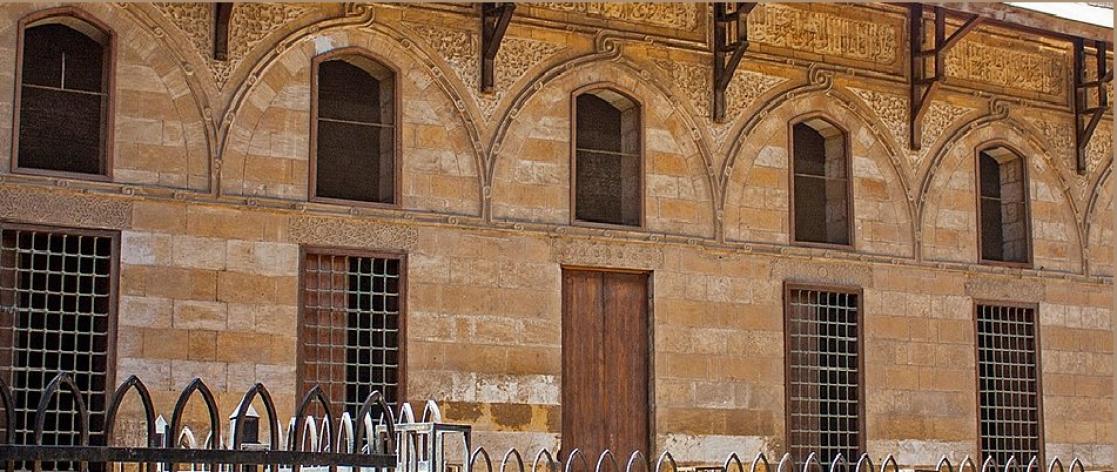Culture Heritage for the Living in the ''City of the Dead''
Context of the project:
The City of the Dead was the burial ground for Sultans and dignitaries in the Mamluk period (1250-1517 AD) and later continued as a cemetery for prominent families. Unlike European Cemeteries, their mausoleums were huge multifunctional religious complexes that employed permanently a considerable number of people. So, in reality the City of the Dead has always been the City of the Living. The area is listed in the World Heritage Site Historic Cairo.
The area differs from other districts of Cairo because of:
- Population density is lower compared to other areas of Greater Cairo;
- Its twofold of necropolis and acropolis;
- The ancient tradition of visiting tombs especially on Thursdays and during religious holidays.
The European Union has funded so far three main projects in the city of the dead for a total of grants that amount to € 1.3 million. The projects have aimed at the conservation of key Mamluk monuments as a drive for the socio-economic development of the local population.

Objectives:
Phase III: The project Heritage for the Living in the ''City of the Dead'' will start on February first, 2018 for a period of 30 months. Total Budget € 1million, EU Contribution is a grant of € 945.000. The project will rehabilitate currently disused and ruined sections of one of Cairo’s most important historic architectural complexes (built in the 1470s) through architectural conservation, and will adapt them for serving the needs of the local community.
It will result in both bringing the historic buildings and spaces physically to a sound condition that enables their use, and in establishing the administrative framework for such use. In result, the quality of life of the local inhabitants will improve thanks to better services (especially basic health care services), improved urban environment, and expanded economic opportunities for local small businesses with the increase of cultural tourism visitation.
The project will use the local workforce as far as practicable, and provide short-term employment opportunities much needed in the ongoing economic crisis and on-the-job training that can improve employment opportunities for the local people.
Accomplishments:
Phase I: Outside In: The art of inclusion The Hawd and the Maq‘ad of Sultan Qaitbay that have been restored through two projects funded by the European Union. The ultimate objective of these projects has been to make culture and cultural heritage accessible to community within the City of the Dead. The Hawd and the Maq‘ad of Sultan Qaitbaye represent two fine examples of conservation and adaptive re-use of tangible cultural heritage for the benefit and development of the local community.
Hawd (drinking-trough for animals) of Sultan al-Ashraf Qaytbay (No.183), A.D.1474 /879 A.H.

The charities providing drinking water to animals (hawd) were not as numerous in Cairo as those serving people (sabil), but quite a number have been preserved. Sultan Qaitbey built at least three in the city. The present look of the stone-built structure is mostly the result of the late 19th century work of the Comité de Conservation des Monuments de l’Art Arabe, but the general outline of the original structure survives, with the back wall of the porch richly decorated in high-quality stone carving typical of the sultan’s reign. The Comité covered the ruined structure with a protective roof. The building was restored in 2014 by a project funded by the European Union. Today it is used by the local community as an art exhibition area.
Project: Outside In: The Art of Inclusion. A Place for Arts and Culture in Cairo's City of the Dead. Total budget € 81.500, EU contribution € 50.000.
Behind the hawd are remnants of service buildings of the once vast funerary complex, including a water-wheel that supplied the hawd. They were preserved by the Comité as a permanent ruin.
Phase II: Maq‘ad of Sultan al-Ashraf Qaytbay (No.101), A.D.1472-74 / 877-879 A.H.

This was once part of a huge palace built by Sultan Qaitbey next to his tomb. A maq‘ad (literally, a sitting-place) was part of every wealthy house in Cairo in Mamluk, and later in Ottoman times. It was a loggia raised over storerooms that were located on the ground floor. It opened on the inner courtyard, the central space of every household, with an arcade of arches supported on stone columns. From here, the master of the house overlooked the activities taking place in the courtyard. This maq‘ad is unusual in being an enclosed hall with multiple windows, rather than an open loggia with arches. The peculiar construction of the front wall suggests that this was perhaps a change to the original plan. A similar hall (also with windows instead of arches) was part of the funerary complex of Amir Kebir Qurqumas nearby. Sultan Qaitbey reigned from the Citadel of Cairo between 1468 and 1496 over an empire comprising Egypt, Nubia, Syria along with Lebanon and Palestine, and the Hejaz.
Project: Outside In: The Art of Inclusion. A Place for Arts and Culture in Cairo's City of the Dead 2nd phase. Total Budget: € 366.000, EU contribution € 293.000.
Quote from Ambassador Ivan SURKOŠ, Head of the European Union Delegation to the Arab Republic of Egypt:
"The European Union attaches great importance to the Egyptian Cultural Heritage, which includes the most important sites of the World Heritage list. It is with great pride that we inaugurate the European Year for Cultural Heritage – 2018, by funding seven new projects protecting the most important cultural heritage sites and support the socio-economic development of the communities living in these sites. The EU is unquestionably committed to support Egypt in protecting our common cultural heritage."
Visit of DG NEAR Director Michael Köhler, 20 January 2018

